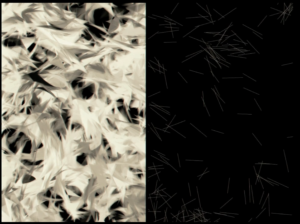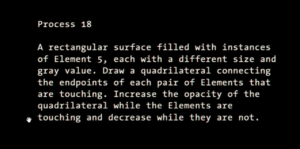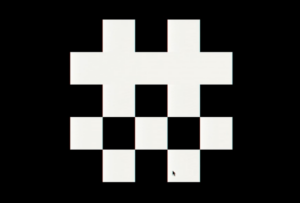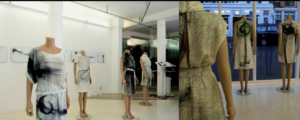The juxtaposition of the artificial, conventionally associated with rigidity and logical order, and the organic, characterized by spontaneity and fluidity, has been historically observed, as Reas illustrates in his talk, since humans ventured into the arts and the sciences. I especially enjoyed Reas’ chronicling of the journey of digital creators and artists marrying these two by exploiting “parameterized change” to give dynamism to their work, starting with the courage of early artists like Jean Arp. I also appreciated his demonstration of how he systemized the process of introducing controlled randomness in his work by formulating algorithmic elements and processes, like element 5 and process 18 that he used to produce the artwork below. As someone who has an understanding of the mathematical quantification of randomness, as defined by measures of entropy, and has also been interested in studying the historical emergence of artistic abstract and surrealist works, I was delighted to see Reas illustrate how both can be integrated, via computational methods, to produce pleasing digital artworks.


It was thought-provoking and almost ironic to see an algorithmic process attempting to simulate constrained randomness. Randomness, by its very nature, assumes the lack of regularization or adherence to a set of well-defined instructions. However, it is indeed possible, as shown by Reas, that despite their antithetical nature, randomness and order can co-exist and synergize to produce beautiful pieces of art.
One thing that caught my attention is Reas’ emphasis on producing from chaos an emergent homeostasis that is balanced and patterned. In the above example, for instance, Reas notes that repeated iterations of his process produce similar-looking, almost “unified,” results. This is essentially a product of “parameterizing” randomness. As Gerhard Richtar also states: “above all, it’s never blind chance: it’s a chance that is always planned, but also always surprising.” In a sense, randomness, then, becomes this beast that needs to be tamed, through order, to produce art that is organic and new, but still has an emergent form to it to be meaningful. This could also be demonstrated by the incorporation of symmetry in the Fractal Invaders animation to produce forms that can be readily interpreted by the viewer but were not necessarily manufactured by the artist.
This got me thinking: why can we not embrace randomness in art in its own right, without the need to constrain it or tame it in any way? Can we re-wire our brains to enjoy the unexpected jitters of white noise? Or derive pleasure from looking at TV static the way we would Renaissance paintings in museums? Lastly, if truly random art were to exist, where would that place the artist?


